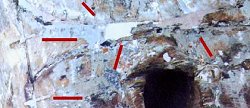

TANGLEY CALLIOPE RESTORATION PROJECT (part 14)
by Dr. Bill BlackINSIDE THE PNEUMATIC STACK
Last month we examined the exterior of the stack and removed the valve units. In PHOTO A, the nipples have been removed and the back of the stack is shown with the vacuum inlet nipple.
The back of the stack is attached with a gasket and screws. In PHOTO B, the back has been removed. The Tangley uses a different approach to stack design than we see in the Wurlitzer stacks. Wurlitzer used channels cut into wood to transport the vacuum to the valves and the pneumatics. The Tangley uses a box type arrangement, the interior of which is under a condition of vacuum. The nipples from the tubing from the tracker bar are connected to each valve by means of a piece of rubber tubing inside the box running to each valve. The air coming in from the tracker bar is transported to the valve by this tubing. So, no channels in the wood are used for this purpose. There are two feeder holes for the vacuum to each valve unit. One hole supplies vacuum to operate the valve and the other supplies vacuum to operate the pneumatic on the valve unit. This arrangement can be seen in PHOTO B.
In PHOTO C we have removed the old tubing and replaced it with new rubber tubing. Each nipple inside the stack is checked to be sure they are tight with no leakage.

In PHOTO D, a new gasket has been made for the back and it has been attached with new screws. The nipples for the tracker bar tubing have been installed on the wood strip and a new finish applied to the back.

PHOTO E shows the front side of the stack with the bleed screw strip installed, also with a new gasket. A leather washer is installed under each bleed screw to insure there is no leakage.
Next month we will restore the valve and pneumatic units.
Dr. Bill Black is one of the nation's most knowledgeble Wurlitzer band organ experts. He has made recordings of many band organs and other mechanical music machines which are available for purchase in our CarouselStores.com website.